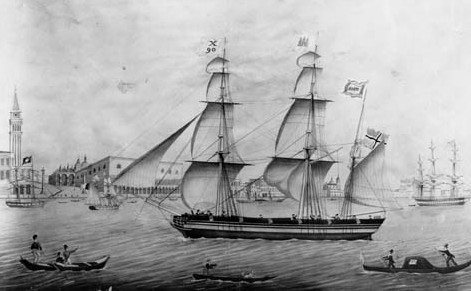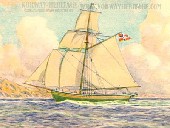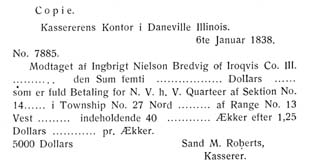THE ÆGIR PEOPLE
By Erling Viksund - Jaunuary 2005 -
This article by Erling Viksund was first published in "Vaksdal Historielags Årbok" 2004. This is the story about the pioneers who emigrated from Hordaland to Amerika on the Ægir in 1837, and the tragedy in the first settlements in Illinois.
On the 7th of April 1837 the first emigrant ship sailed from Bergen to USA. The ship's name was Ægir and there were 84 emigrants onboard. Most of them were from Hordaland and 12 of these were from the present municipality of Vaksdal. The bark Ægir (God of the Sea) was a solid, bark-rigged ship at 62 'kommersielester' (129 reg. tons), built in 1835 in Bergen and classed in The Norwegian Veritas. Ægir's captain and the owner was Christian K. Behrens. He had studied German and American emigrant ships in New York and in this manner had gained insight into how emigrant ships should be equipped and adjusted to better accommodate passengers on such a long journey.
There had been a limited emigration earlier with ships from Rogaland. The first Norwegian emigrant ship was "Restaurationen", which was merely 16 metres long and 5 metres wide and measured 18.5 kommersielest, i.e. approximately 38 reg. tons. This sloop-rigged Hardanger yacht sailed from Stavanger in 1825 with a total of 52 pioneers from Rogaland as passengers to America.
The Restaurationen selected a southern passage south of Madeira and the voyage took 14 weeks. The fact that 52 persons could cross the Atlantic to a new and unknown country in a sailing yacht of this size stands as one of the most impressive accomplishments in Norwegian-American history.
In 1836 two emigrant ships, "Den Norske Klippe" and "Norden" sailed from Stavanger with a total of 167 passengers to America. A minor Norwegian emigration had also taken place over other European ports such as Gothenburg, Liverpool, Hamburg and Le Havre.
Cleng Person from Tysvær in Rogaland is regarded as the 'father' of the Norwegian emigration, and in 1825 he settled near the Kendal Township in the State of New York together with the people from the sloop Restaurationen. Cleng Person was a restless soul and wandered further west to Illinois in 1833 and founded the Norwegian settlement Fox River in La Salle County. These early settlers sent 'America-letters' home, which were diligently copied and read in Norway. One of the most renowned correspondents, Gjert Hovland, wrote as follows:
"I wish, without the least of doubt, that all my family in Norway should be here - A few of these early emigrants visited their old country and told of the new Promised Land. Knut Slovik's return in 1836 was among the best known of these visits, and his tales spread rapidly across the land. Mons K Langeland Ådland wrote that in America the farmer is as highly regarded as the president, and that in America the 'little' man did not have to remove his hat for the big shots he met. On this background the 'America fever' eventually spread to Hordaland. Also contributing were the underlying domestic causes such as the political, religious, social and economic conditions, which often were the triggering factors for the decision to emigrate. One of the main reasons for emigrating was the large number of children per family and the shortage of arable land for the burgeoning farmer population. The law proscribed a simple ambulatory school and most people were reasonably literate.
The country's authorities, including county sheriffs and the clergy, were often in disaccord with the public and were, by and large, satisfied with the situation in the country at the time. Bishop Jacob Neumann in the Bergen diocese was concerned about the emigration because he saw that it would deplete the country's human resource, and in 1837 he wrote a lengthy pastoral letter warning those farmers in the diocese who harboured thoughts of emigrating. The letter said, among other things: "Remain in the country and sustain yourselves by honest toil". The emigrant Knud K. Langeland (b. 1813) was wise and also a particularly good writer and in his letters he answered the bishop's biblical quote as follows: "Either the bishop forgot, or he did not find it expedient under the circumstances, because the bishop did not mention the other command in the scriptures which says: "Be fertile, multiply and people the earth."
The farmers had heeded this last command and most of them had large families. When the land at home was more than filled and they heard that the new world had immense, unsettled areas with fertile soil, they decided to disobey the bishop and to travel to the new Canaan flowing with milk and honey. It soon became evident that the 'America fever' continued to spread, despite the bishop's pastoral letter and other warnings.
For this reason, captain Behrens had no problem getting passengers from Hordaland for Ægir's first emigrant voyage from Bergen to New York in 1837.
Since this story deals with the first emigrant ship from Hordaland, it may also be of interest outside our municipality. In view of the close family ties between our community, Samnanger and the hamlets in Voss, it is in order to include the entire passenger list from Ægir's voyage from Bergen to New York in 1837.
Overview of passengers from the present Vaksdal municipality. 3. J. J. Dale 40 m 5. Agate Jonsdtr. Dale 7 f 6. John J. Dale 4 m 7. Tomas Nilsen Ytre Boge 61 m 11. H. N. Dalseidet 36 m 12. O. A. Dyvik 24 m The complete list of passengers on the Ægir.
General description of the first pioneers from Hordaland. Emigrating was a substantial financial investment. In addition to travel money, the emigrants also had to finance or furnish the requisite personal belongings and food. According to Ole Rynning's description, personal belongings should at least include: bedding and linens, furs and wool clothing, wool cloth, griddle, spinning wheel, hand quern, pans, crockery, cutlery, tools and a good rifle with percussion lock. Also according to Ole Rynning's recommendations: food for 12 weeks consisting of preserved foods such as: salted pork, smoked and cured meat, salted meat, smoked and cured herring, dried fish, butter, cheese, soft whey-cheese, coffee, tea, sugar, sour milk, beer, flower, peas, grits, potatoes, rye biscuits, rusk and flatbread, some liquor, vinegar, prunes and raisins for constipation, sulphur salve and powder for vermin, Hoffman's and camphor drops, spare linen, saltwater soap and combs. Emigration in those days involved considerable planning, preparation and cost.
Finally, all the equipment, animals and land for the new 'farm' had to be purchased. At that time the price for an acre of land was USD 1.25 ( 1 acre = 4046.9 m2). This was before the enactment of the Homestead Act in 1862, which guaranteed free land to immigrants. In 1838 the purchase of land often amounted to USD 50, which is evidenced below by a copy of the deed obtained by Ingebrikt Nilsen Brudvik Dale:
Those who lacked the necessary capital for the purchase of their own land, had to go into paid labour, and jobs were plentiful in their new country. The wages were good and most of them saved their money so that in time, they could also buy their own land.
The voyage across the ocean to the new fatherland In bad weather, the passengers had to stay below, with insufficient ventilation, rationed drinking water and terrible sanitary conditions. Captain Behrens also functioned as the ship's doctor and could cure seasickness with barley soup, and other ailments with the strong sailors' medicine of those days. These seasoned and strong people from our various country settlements were not used to the life on the ocean, but they did not complain; they were pioneers and showed a unique toughness, courage, strength and willpower.
They were, of course, marked by strong feelings when they, after having packed their belongings and said goodbye to friends and kin, rowed out Sørfjorden the 30 nautical miles to Bergen. The emigrant poem below illustrates the mood aboard the boats as Sørfjorden slipped past and their homes and beloved landscape with Dystingen, Hananipa and Brøknipa disappeared from sight - but not from thought.
In their minds the expectations of their exciting and unknown new country mixed with the sadness and sorrow of leaving the old hamlets with friends and kinfolk that they were likely never to see again.
Captain Behrens cared for the well being of his passengers, both in body and soul. He arranged a 17th of May (Norw. independence day) celebration onboard, with singing, fiddle music and dancing.
The passengers were in a festive mood and wore their best national costumes, but they had irons under their shoes and after a while the captain had to stop the dance because the deck was taking a hard beating. Ole Rynning also proved to be a formidable cultural exponent; he wrote a gripping song that was performed there in the middle of the ocean on the 17th of May 1837. Two of the verses are included here, freely translated from the original gothic lettering and the style of writing at that time:
Increasingly, intense excitement and anticipation filled their minds as Ægir under full sails and a good wind saw the North Atlantic slip behind in the bright and balmy days of spring.
Ægir arrived in New York on the 10th of June and after formal immigration procedures the passengers could set foot on their new fatherland. The New York newspapers described in admiration these proud people who strode forth in the city's streets in their colourful costumes.
The journey westward was by steamship up the Hudson River to Albany and then from Albany to Buffalo on the Erie Canal in a canal boat pulled by horses. From Buffalo by steamship across the big lakes Erie, St. Clair, Huron and Michigan to Chicago, where they arrived on the 12th of July. The journey from Chicago south to Beaver Creek and west to Fox River was by wagon train and on foot.
The journey westward and the tragedies in the first settlements in Illinois at Beaver Creek and La Salle. Until then, Beaver Creek had been an uninhabited area that was described as a paradise with grass growing up under a person's arms, and the area looked appealing enough when the Ægir people arrived there in late summer. The people selected their land, built their simple log cabins and struggled through the first hard winter. However, it soon became clear that the choice of Beaver Creek was a disaster. With the coming of spring the district was more or less submerged in water until far into the month of June. This climate brought malaria and other deceases that claimed 15 lives the first years. These dear old relatives of ours went through indescribable suffering far out into what was then a wilderness without medical or other help. Entire families were erased. The disaster at this first settlement left deep wounds in the people and before long Beaver Creek was abandoned. Similar epidemic deceases also ravaged the population at La Salle, although not to the same dramatic extent as at Beaver Creek. The people from our villages in Bruvik parish suffered particularly heavy losses as 6 of the 12 emigrants died during the first year.
About the Ægir people's further journey westward to new settlements, and generally about this first epoch of Norwegian emigration to America.
The map shows the area in Beaver Creek that was parcelled out to the settlers. Ingebrikt N. Brudvik bought land in section 14 and Tomas Nilson Ytre Boge bought land in section 22.
After a taxing voyage from Norway and the hazardous circumstances in the initial period, the emigrants' health was in a terrible state. These conditions seriously drained the early settlements, but families with 10 to 15 children were not unusual, and vigorous societies eventually developed. These first pioneers from Hordaland participated in establishing the new colonies and were in fact among those who went first, gaining experience and knowledge and showing the way and the routes to travel. The emigrants who arrived later followed to a large extent the safer routes established and made known by the first pioneers, who paid a high price for the knowledge about their new land, such as at Beaver Creek and La Salle.
From this first phase of Norwegian immigration from 1838 to 1850 the following Norwegian settlements are mentioned here: Jefferson Prairie, Rock Prairie, Muskegon, Racine and Koshkong. These areas were settled primarily by Norwegians and quickly prospered. Most of the emigrants became farmers and they had learned to select good, virgin land that gave bountiful harvests and expanded quickly under the care of the pioneers. The farmers grew wheat, corn, potatoes and tobacco and raised pigs, sheep, cattle and poultry. Taxes were very low in those days at USD 1.50 per year for a farm of 80 acres plus a couple of days of road-building duty. From the stories after Knut K. Langeland we can see that some of these first emigrants from our district developed model farms out of very poor initial circumstances. They prospered over the years and became wealthy by local measure. The settlements mentioned above grew rapidly and between 1838 and 1850 they received 543 Norwegian families with a total of 2670 persons. Later epidemics of smallpox and cholera and the Indian uprising in the 1860's caused severe setbacks for the settlers.
But in spite of this, the Norwegian settlements grew with a marvellous vitality. The first Norwegian church was inaugurated in Muskegon in 1845, and today the Muskegon church can be found on the property of Seminary St. Paul in Minnesota.
The renowned Norwegian-American newspaper publisher Knut K. Langeland was born in 1813 in Samnanger and emigrated in 1844. He is the best-known publisher from the pioneer times and published, among other things, the paper "Skandinaven" until 1871. "Skandinaven" was of great importance to the Norwegian emigrants in the pioneer period and the feeling of being Norwegian was very strong among the emigrants. The most famous Norwegian emigrant was Knute Nelson from Voss, and to Knut Langeland he wrote as follows: "What wondrous vitality there was in the old farmer! After having been trodden down for 400 years they shoot up with all their original Viking strength - in the old world and in the new."
Already in 1860 more than 55 000 Norwegian immigrants lived in the states of Illinois, Wisconsin, Iowa and Minnesota. This population made up 100 congregations with 29 priests.
Abraham Lincoln lived in Illinois before he became president in 1860, and his visions and ideas of freedom and the fight against slavery also had many adherents among the Norwegians.
At this time the American East Coast was relatively well developed and had large urbanised areas. In the Southern states wealthy landowners operated their plantations with slaves, and human rights and liberty for all were not well established. The first Norwegian immigrants therefore met a very complex society. In the descriptions from his journey in 1844, the rich property owner Johan Gasman gives us an insight into the wealthier and more developed segments of American society. Here we can easily imagine the strong impression the "promised land" made on the pioneers from our villages.
The civil war from 1861 to 1865 caused fundamental changes in American society and it was at this time that the mass emigration from Norway to USA started. From the first Norwegian emigrants in 1825 more than 850 000 Norwegian men and women followed until 1915. Only Ireland had more emigrants than Norway in this period.
In the emigrant museum on Radøy there is, beautifully displayed, a bible the Ægir people from Hordaland had with them in 1837. Peace and dignity surrounds this beautiful memory of our old district folk and friends who with their lives in the balance became pioneers in America. And at this point it seems fitting with a slightly edited version of the poet's word: "de tok sin gud i sinn og satte livet inn" (they put their trust in God and went on to risk their lives).
Liste over alle som var passasjerar på "Ægir"
Sources:
Rolf Erik Veka - Vaksdal Historical Society
particularly those who need the most and must suffer in the forced service of others so that they have little sustenance left for themselves and their families; because here you find no unnecessary burdens imposed for anything - either in the form of taxes or other expenses to support useless persons, who wish to live by the sweat of others....
Here one can see a lot of wonderful and fertile land and diligence and wealth nearly everywhere one goes. Everywhere there is sowing and planting of everything one needs. It all grows well and the yield is several-fold without fertiliser....
As regards religion, everyone is of liberty to use the teaching he himself prefers and acknowledges....
There is an immense expanse of land that the United States sells for three 'ort' per acre (1 ort = 24 shilling), and all is governed by a written law that specifies this price, so that those first buying it from the government shall never have to pay a higher price....
If anyone should think of moving here, which probably will not happen because many are so stupid as to believe it a bad thing to move to a foreign country, where they could easily support themselves and their families, but prefer to live in the land where they were raised even if they don't have bread on the table; and many back there cannot afford to travel the long way over here."
1. Ingebrikt N. Brudvik Dale 48 m
2. Synnøve Monsdatter 40 f
The childless couple Ingebrikt (1790-1838) and Synnøve (1790-1861) was from Dale and had a farm on Osterøy, which they sold. They purchased section 14 in Beaver Creek where Ingebrikt died of malaria in 1838 while Synnøve survived and sold the farm in 1839.
4. A. Sjursdatter 33 f
Nr. 3 Jon (1795-1882) was from Dale and 4 Anna (1803-1839) was from Vaksdal. They were married and had two children, see 5 and 6. Anna and Jon took land in La Salle, Illinois where Anna died in 1839, while Jon left and took land in Racine, Wisconsin and lived there until 1882. Jon then married Anna Arnesdotter Nygrytten b. 1800 from Kyte in Voss. This marriage was barren.
Agate, the daughter of 3 and 4, survived and eventually married Knud Aslaksen Svalestuen b. 1817 from Voss and they took land in Racine, Wisconsin. Agate and Knud are buried in the Muskego Lutheran Cemetery. Agate and Jon had 15 children: John (1846-1908), Aslak (1849-1933), Richard (1851-), Martin (1854-), Martha (1855-1919), John Newton (1857-), Anna M. (1859-), Edvin (1860-), Edvin Norman (1861-1908), Reuben (1861), Anne M. (1865-), Reuben Augustus (1868-1948), Oskar (1870-), Oskar O. (1871-1935), Jon Newton (1875-1933).
John (1833-) was the son of 3 and 4 and married Christina b. 1836. They had 2 children: Julianna (1857-), John (1859-).
8. Ingeborg Johannesdatter 61 f
9. N. Thomassen 27 m
10. S. Johannesdatter 52 f
Tomas N. Ytre Boge (1775-1838) was married to Ingeborg Johannesdotter Y. Boge (1775-1838). He gave the farm (nr. 4) in Y. Boge to his oldest son Johannes and went to America with his wife and son (9) Nils (1809-1838). Also emigrating to America with the family was Tomas' sister (10) Sigrid Johannesdotter Y. Boge (1783-1838). All 4 from this farm died of malaria the first year on their new farm in Illinois.
Haldor Nilsen Dalseid (1801-) married Larine Bogar in 1841 and they took land in La Salle.
Olav Andersen Dyvik (1803-) from Dyvik married Kristi Olsdotter Bolstad (1812-1888) in 1832. He sold the farm and emigrated alone on Ægir in 1838. He was one of the survivors in Beaver Creek. In 1845 he went back to Norway to get his wife, and they took land in Newark, Illinois. Olav and Kristi are buried in Helmer Lutheran Cemetery, Newark. They had 5 children before they went to America and had another 5 children in their new homeland. Children born in Norway: 12.1 Anna (1833-1909), married to Lars Nilson Bidne (1819-) from Granvin and this couple had 9 children: Fremont - Elisabeth - Josephine - Isaiah - John - Lewis - Iver - Arthur William - Anna Bella. 12.2 Anna (1835-). 12.3 Sigrid (1837-1921) married to Ivar Nilson Bidne (1819-1921) and this couple owned a farm in Big Grove TP, Illinois and had 11 children: Sarah - Ella - Laura - Anna - William - Mary Ann - Joseph Almer - Ester Loise - C Marten - Stella - Frederic - Clara. 12.4 Martha (1839-1924) was married to Knut Johannesen Grevle (1827-1896), and this couple had 8 children: Thomas - Ed - Frank - Albert - Christine - Belle - Anna - Marthe. 12.5 Anders (1843-). 12.6 Mons was born and died on the voyage in 1845. Children born in USA: 12.7 Ole Isaac (1846-). 12.8 John (1846-). 12.9 Isaac (1850-). 12.10 Anne Christine (1845-).
As the passenger list shows, most of them were country folk, very often young people, and emigration of entire families was the rule. The farmers had capital tied up in their land, and by selling this they obtained enough to finance the trip and a modest start in their new home country. Labourers had more difficulties with the financing, but they managed with savings, inheritances and loans and to some extent by entering into labour contracts
The 27 years old student Ole Rynning was one of the passengers onboard Ægir, and it soon became apparent that he had formidable leadership talents and he became the natural leader of the Ægir people. Ole Rynning was one of the poor souls who fell ill and died in Beaver Creek in 1838. His writings tell of the prices of tickets, which from Bergen to New York was 30 SPD and as high as 20 SPD for children. The price from New York to Illinois was 30 SPD. The Norwegian SPD (Speciedaler) was worth approximately a quarter of a US dollar at that time.
The voyage across the ocean followed a northern route in good weather and lasted a little over eight weeks. The most dramatic event was when Ægir on the 8th of May was involved in a minor collision in mid-ocean with the British ship Barletto. Many of the passengers panicked, but Ole Rynning soon calmed them down. The conditions onboard where, of course, very miserable and seasickness was a scourge, particularly in the beginning of the voyage. It is only with difficulty that we now, 166 years later, can imagine how the travelling families managed their ablutions, and how they could sleep and eat, each with their own, packed provisions.
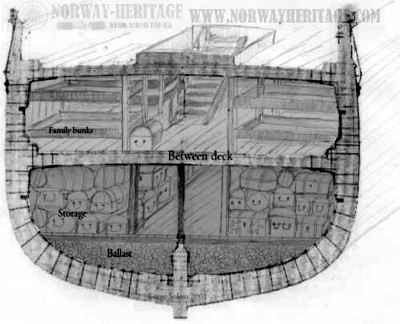
With heavy foot we now are leaving
our dear beloved childhood land
If only this deed undone could be
our home is left behind to grieve
away forever now we go 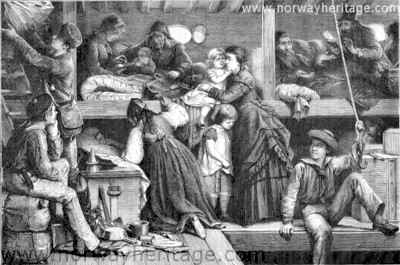
Now Norway's rocky land
lies hid by salty wave,
our longings go to yonder strand
with old birch trees and oak so brave
and fir trees' whisper and glaciers' song
are harmony for Norway's son. Though fate only gave him there
the simple shelter of a bear,
he still will hold them very dear
his old Norwegian mountains
he longs so tenderly in secret mind
to see his fatherland again some time.
Before the departure from Norway, most of them were determined to take land by Fox River in Illinois. However, during the stopover in Chicago, they were informed by people with knowledge of the area that there was swampland around Fox River with infectious deceases. The journey westward was therefore reconsidered and the various alternative settlement options were discussed. This new perspective lead to problems in selecting the proper destination for the Ægir people. Fifty of the emigrants eventually decided to establish a colony at Beaver Creek in Iroquois County in Illinois near the Indiana border. Others went on to La Salle, Fox River, while the rest wandered far and wide and eventually found land in places they liked.
The survivors among the Ægir people from Hordaland wandered further west, most of them to areas that later became the State of Wisconsin, which attained statehood in 1848. Their journey at this time was for the most part through unknown country; Indiana became a state in 1816 and Illinois followed in 1818. They travelled on foot and by covered wagons pulled by horses or oxen. Illness and deprivation marked this first period in the new homeland. Most of them had exhausted their resources once they had built their first and often primitive homes.
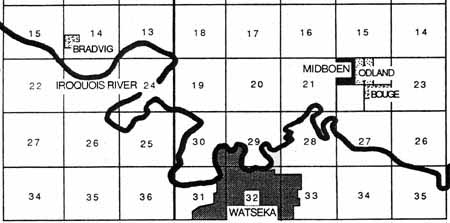
Illustration: Map of settlements along the Iroquois River near Watseka. Courtesy of C. Robert Sanders.
Village books for Haus - Samnanger - Bruvik - the Bolstad book.
"The road to the West" - Ingrid Semmingsen (1941)
"The Norwegians in America" - Knut K. Langeland (1889)
The Maritime Museum in Bergen : Pictures of Restaurationen and Ægir.
Internet / Emigrants / The Promised Land / fulltext: "Truthful Description of America" - Ole Rynning (1838)
Pastoral letter 1837, Bishop J. Neumann warning farmers in Bergen diocese.
"From New York to Wisconsin in 1844" by Johan Gasman.
List of passengers from Solem, Swiggum & Austheim emigration ship index.

